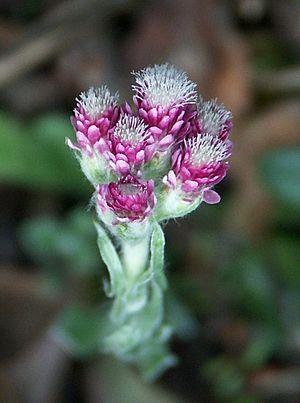Mountain everlasting facts for kids
Quick facts for kids Mountain everlasting |
|
|---|---|
 |
|
| Scientific classification | |
| Synonyms | |
|
Synonymy
Antennaria hibernica Braun-Blanq.
Antennaria hyperborea D.Don Antennaria insularis Greene Antennaria montana Gray Chamaezelum dioicum Link Cyttarium dioicum Peterm. Gnaphalium alpinum Asso ex DC. Gnaphalium boreale Turcz. ex DC. Gnaphalium dioica L. Gnaphalium dioicum L. Gnaphalium hyberboreum Winch ex DC. Gnaphalium pes-cati Garsault |
Antennaria dioica, also known as mountain everlasting, stoloniferous pussytoes, catsfoot, or cudweed, is a type of flowering plant. It belongs to the Asteraceae family, which includes daisies and sunflowers.
This plant grows in cool, northern, and mountainous areas. You can find it across Eurasia (Europe and northern Asia) and in North America, specifically in Alaska. In Asia, it grows in countries like Russia, Mongolia, Japan, Kazakhstan, and parts of China.
What Does It Look Like?
Antennaria dioica is a herbaceous perennial plant. This means it's a plant that doesn't have a woody stem above ground and lives for more than two years. It usually grows to be about 10–20 centimeters (4–8 inches) tall.
The plant has a group of spoon-shaped leaves at its base. These leaves are about 4 centimeters (1.6 inches) long. Smaller leaves are arranged in a spiral pattern along its flowering stems.
The flowers grow in small clusters called capitula or flowerheads. Each flowerhead is about 6–12 millimeters (0.2–0.5 inches) wide. They have pale pink ray florets (the petal-like parts) and darker pink disc florets (the tiny flowers in the center).
Reproduction
This plant is usually dioecious. This means that individual plants are either male or female, having separate male and female flowers on different plants.
Interestingly, Antennaria dioica can also reproduce without needing fertilization. This is a type of asexual reproduction. You might find groups of these plants that are all female, all male, or a mix of both.
You can often tell the difference between male and female plants by their flowers. The male plants tend to have whiter flower heads compared to the female plants. The name dioica comes from a Greek word that refers to these separate male and female plants.
Traditional Uses
Historically, Antennaria dioica was used in traditional herbal medicine, though it's not widely used today. People believed it had properties that could help with coughs, tighten tissues, increase urine flow, and soften the skin.
It was traditionally used to help treat problems like bronchitis (a chest cold), issues with the liver and gall bladder, hepatitis (liver inflammation), and diarrhea. When used externally, it was sometimes made into a gargle to help with tonsillitis.
In 1597, John Gerard wrote about this plant in his book, Herball. He noted that the flowers could stay fresh for a whole year if gathered when young. Because of this, English women called it 'Live Long' or 'Live-for-ever', which perfectly described its ability to stay fresh for a long time.
Images for kids
See also
In Spanish: Pie de gato para niños


